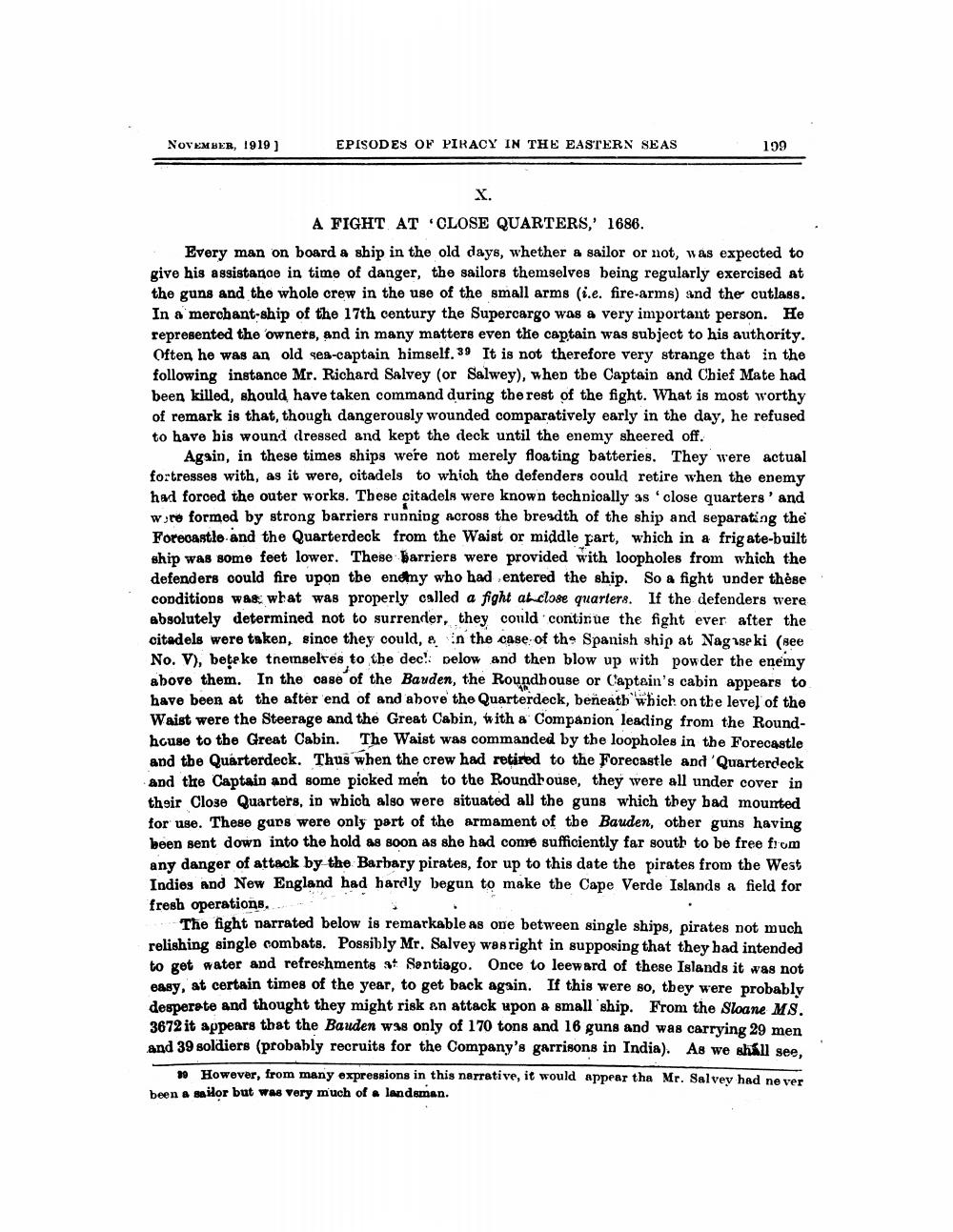________________
NOVEMBER, 1919]
EPISODES OF PIRACY IN THE EASTERN SEAS
199
X.
A FIGHT AT CLOSE QUARTERS,' 1686.
Every man on board a ship in the old days, whether a sailor or not, was expected to give his assistance in time of danger, the sailors themselves being regularly exercised at the guns and the whole crew in the use of the small arms (i.e. fire-arms) and the cutlass. In a merchant ship of the 17th century the Supercargo was a very important person. He represented the owners, and in many matters even the captain was subject to his authority. Often he was an old sea-captain himself. 39 It is not therefore very strange that in the following instance Mr. Richard Salvey (or Salwey), when the Captain and Chief Mate had been killed, should have taken command during the rest of the fight. What is most worthy of remark is that, though dangerously wounded comparatively early in the day, he refused to have his wound dressed and kept the deck until the enemy sheered off.
Again, in these times ships were not merely floating batteries. They were actual fortresses with, as it were, citadels to which the defenders could retire when the enemy had forced the outer works. These citadels were known technically as close quarters' and were formed by strong barriers running across the breadth of the ship and separating the Forecastle and the Quarterdeck from the Waist or middle part, which in a frigate-built ship was some feet lower. These barriers were provided with loopholes from which the defenders could fire upon the enemy who had entered the ship. So a fight under thèse conditions was what was properly called a fight at close quarters. If the defenders were absolutely determined not to surrender, they could continue the fight ever after the citadels were taken, since they could, e in the case of the Spanish ship at Nagaseki (see No. V), beteke themselves to the dec!: below and then blow up with powder the enemy above them. In the case of the Bauden, the Roundhouse or Captain's cabin appears to have been at the after end of and above the Quarterdeck, beneath which on the level of the Waist were the Steerage and the Great Cabin, with a Companion leading from the Roundhouse to the Great Cabin. The Waist was commanded by the loopholes in the Forecastle and the Quarterdeck. Thus when the crew had retired to the Forecastle and 'Quarterdeck and the Captain and some picked men to the Roundhouse, they were all under cover in their Close Quarters, in which also were situated all the guns which they bad mounted for use. These guns were only part of the armament of the Bauden, other guns having been sent down into the hold as soon as she had come sufficiently far south to be free from any danger of attack by the Barbary pirates, for up to this date the pirates from the West Indies and New England had hardly begun to make the Cape Verde Islands a field for fresh operations.
The fight narrated below is remarkable as one between single ships, pirates not much relishing single combats. Possibly Mr. Salvey was right in supposing that they had intended to get water and refreshments at Santiago. Once to leeward of these Islands it was not easy, at certain times of the year, to get back again. If this were so, they were probably desperate and thought they might risk an attack upon a small ship. From the Sloane MS. 3672 it appears that the Bauden was only of 170 tons and 16 guns and was carrying 29 men and 39 soldiers (probably recruits for the Company's garrisons in India). As we shall see,
30 However, from many expressions in this narrative, it would appear tha Mr. Salvey had ne ver been a sailor but was very much of a landsman.




